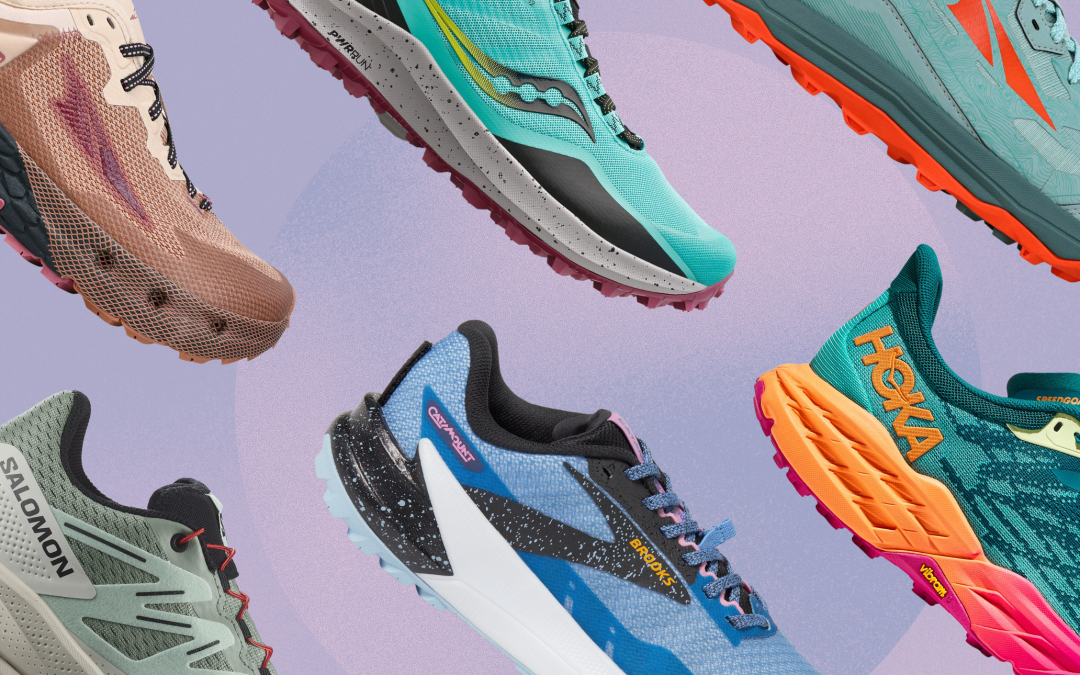Either way, the shoe should feel comfortable and not restrictive, and your toes should not be overcrowded. If you plan to primarily run in hot temperatures, you may want to size up half a size to accommodate foot swelling.
Cushioning
Trail running shoes are usually classified as either minimal, moderate, or maximum cushion. “I choose cushioning dependent on the terrain,” ultrarunner Katie Kommer tells SELF. If you prefer a comfy, stepping-through-clouds running experience, look at shoes with more padding in the midsole. (The sole of these shoes will be thicker than a less-padded shoe.) “For recovery miles on mellow trails or roads, I use max cushion,” says Kommer. Keep in mind that extra cushioning often comes at the sacrifice of stability, so these shoes are best for moderate or long-distance trails, rather than super-technical terrain. Minimal or moderately cushioned shoes will offer a better feel for the trail, so you’ll know what’s under your feet and be able to move lightly and quickly. For these trails, Kommer recommends around 25-mm stack height (which refers to how high the heel is above the outsole) because it provides “protection from rocks but is still nimble.” Minimalist shoes are a better choice if you’ll be mixing your trail running with rock scrambling.
Water Resistance
You can let your preferred running weather and routes determine whether you need to prioritize water resistance in your trail runners. If the majority of your runs will be in wet conditions or in the snow, then you may want to look for a waterproof lining. Many brands use Gore-Tex to make their shoes waterproof, but some have their own proprietary materials. On the other hand, if you’re only getting one pair of shoes for all your trail runs and you’ll be running in many different conditions, you probably don’t want a fully waterproof trail shoe, because it won’t be as breathable and could make your feet sweat. Mountain runner Chanh Nguyen always opts for non-waterproof shoes. “If [my shoe] gets wet, I want the water to escape, not be trapped inside it,” he tells SELF.
Outsole
The shoe’s outsole is a crucial feature for trail runners—and often what separates road running shoes from ones that are trail capable. Specifically, the lugs and flexibility of the outsole play key roles in how the shoe will feel on your run. Some trail runners have soft rubber outsoles, while others are more rigid. A softer outsole will allow the shoe to flex with your foot, which is important to get more surface area in contact with the ground. However, it won’t be as durable as harder rubber. “If I’m going on a mountain run where there will be a lot of rocks, I’ll choose something tough and stiffer,” says Nguyen, whereas “if it’s an actual trail run, I will choose something more flexible that will allow me to run easily.”
Then there’s the lug pattern: Deeper lugs will allow for better grip, potentially meaning fewer slips and falls. Look for an aggressive lug pattern, like on the Salomon Speedcross, which has deep, arrow-shaped lugs, if you plan to wear your shoes on rugged trails or in mud. If you want to keep it mellow on dirt paths—or have the versatility to run roads too—look for a more moderate lug pattern that isn’t as shallow as a road shoe’s sole, but not as deep as those on an aggressive trail shoe. The Nike Pegasus has an excellent iteration of a moderate lug sole.
The best trail running shoes
Whether you’re getting your very first trail shoe or you need to replace an old worn-out pair, these trail running shoes are the top options out there. Read on to explore a range of options from major shoe brands like Salomon, Hoka, the North Face, Nike, and more from retailers like REI, Backcountry, and Amazon.
All products featured on SELF are independently selected by our editors. However, when you buy something through our retail links, we may earn an affiliate commission.

